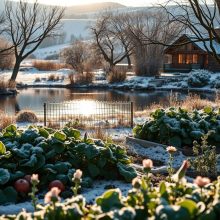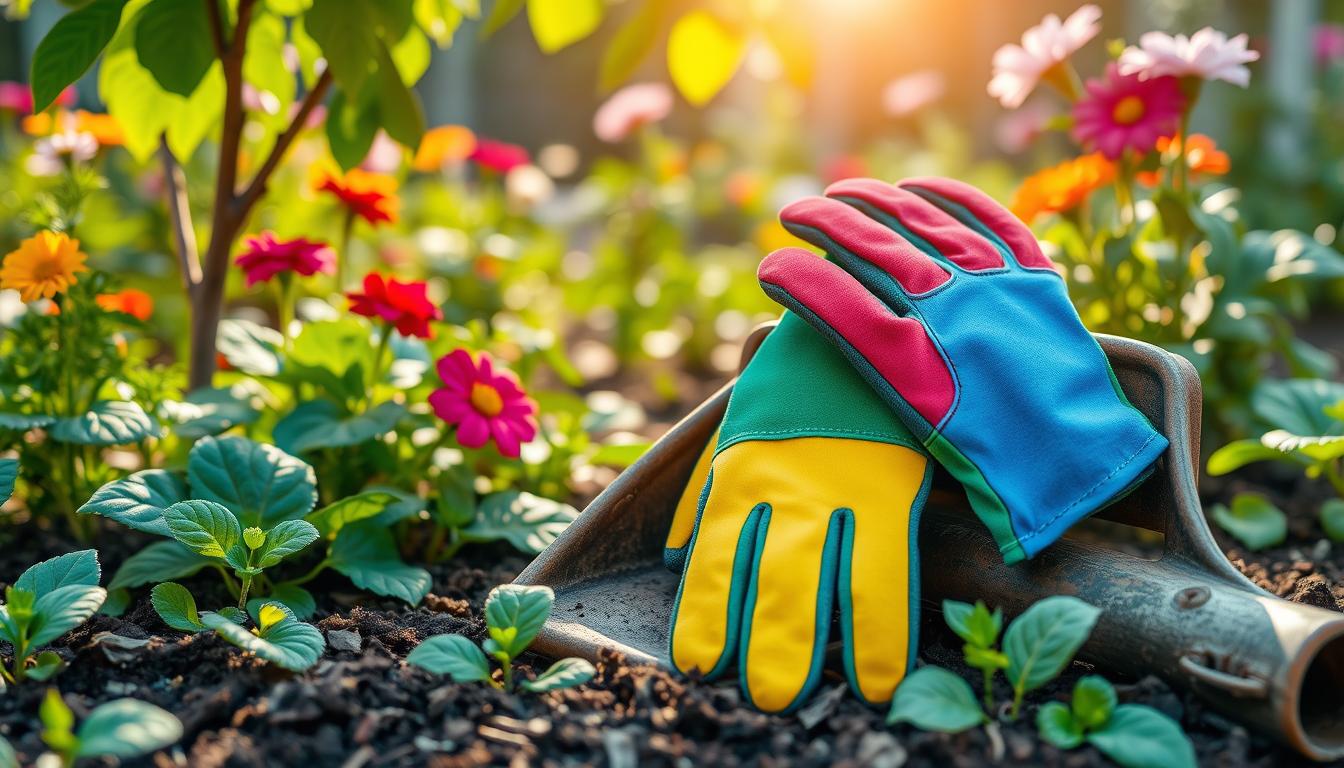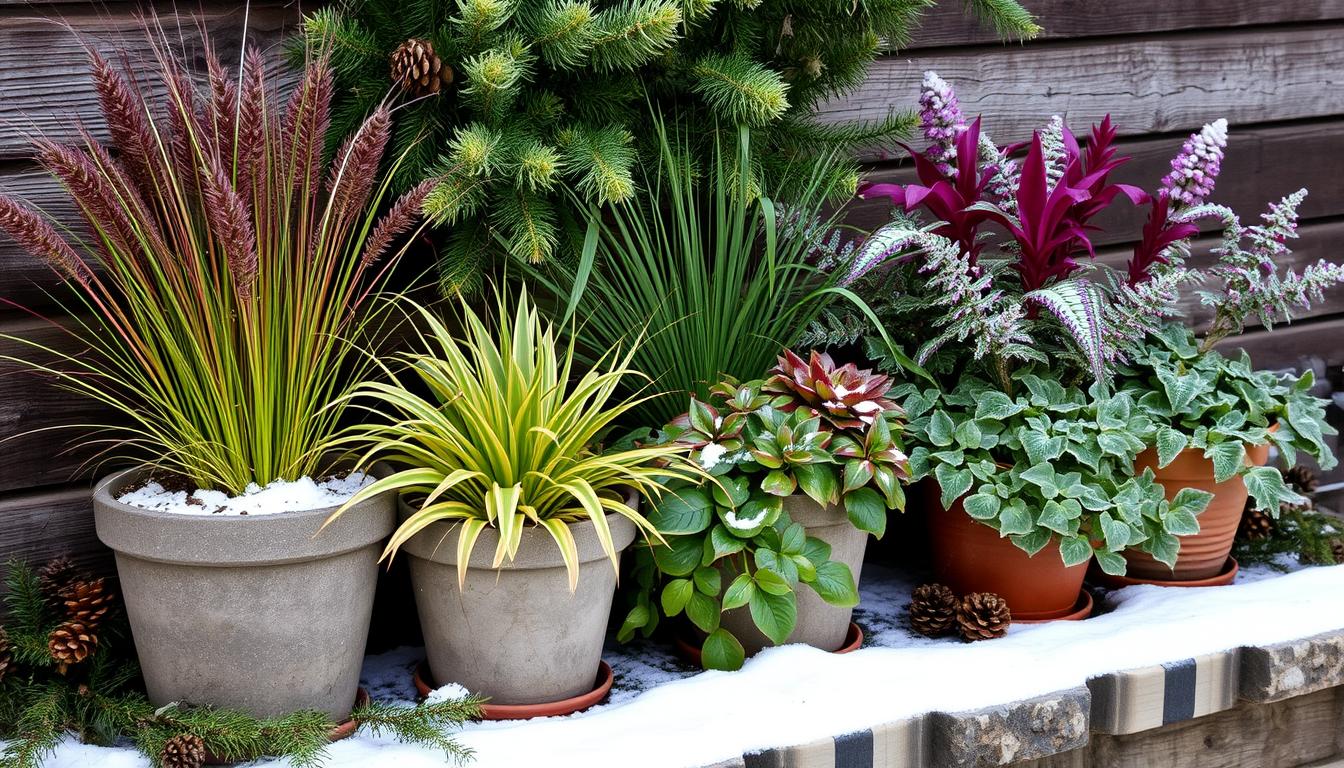Secrets to Successful Winter Gardening: Thrive in Cold Weather
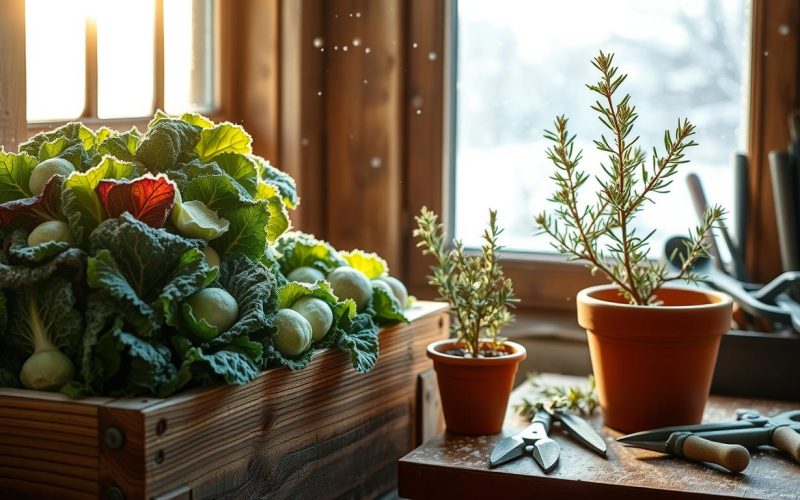
Winter gardening opens up a world of possibilities for passionate gardeners. It lets you make the most of your growing potential. Cold weather gardening is not just a challenge but an opportunity to transform your outdoor and indoor spaces into productive green havens during the chilliest months.
Embracing winter gardening means reimagining your garden’s potential beyond traditional growing seasons. By understanding specific techniques and selecting the right plants, gardeners can create vibrant landscapes that flourish even when temperatures drop. This comprehensive guide will explore strategies to help you succeed in winter gardening.
Growing vegetables and flowers during winter provides numerous benefits. From reducing grocery expenses to maintaining mental wellness during darker months, cold weather gardening offers a rewarding experience for both novice and experienced gardeners.
Key Takeaways
- Winter gardening extends growing seasons beyond traditional timelines
- Cold weather cultivation offers psychological and economic advantages
- Specialized techniques enable successful plant growth during winter
- Diverse plant selections can thrive in low-temperature environments
- Indoor and outdoor gardening strategies complement each other
Understanding the Basics of Winter Gardening
Winter gardening turns the cold season into a chance for plant lovers to keep growing. It lets gardeners care for plants even when it’s chilly. This way, they can keep their green spaces thriving.
Winter gardening is more than just growing plants in winter. It requires careful planning and special techniques to protect plants in the cold. Gardeners use different methods to make their winter gardens successful.
Exploring Winter Gardening Defined
Winter gardening is a special way to grow plants in the cold. It includes:
- Selecting plants that can handle the cold
- Using things like cold frames to protect plants
- Using tips to help plants survive the winter
- Creating special environments indoors and outdoors
Remarkable Benefits of Winter Gardening
Winter garden care has many benefits for gardeners:
- It lets you grow plants longer
- You can have fresh food in winter
- It keeps you connected to nature
- It makes your garden stronger
- It’s a way to grow food without spending a lot
Winter gardening breaks the rules of traditional growing. By knowing what plants need and using protective methods, gardeners can turn their spaces into green havens all winter.
Choosing the Right Plants for Winter
Winter vegetable gardening lets you grow fresh food even when it’s cold. Picking the right plants can turn your winter garden into a lush, green oasis.
To garden well in winter, know which plants can handle the cold. Not all veggies are tough enough for winter.
Hardy Vegetables for Cold Weather
Some veggies love the cold and keep giving you fresh food all winter. These hardy heroes include:
- Kale – extremely cold-tolerant and packed with nutrients
- Carrots – sweeten with frost exposure
- Brussels sprouts – thrive in temperatures as low as 20°F
- Spinach – can survive under snow cover
- Winter radishes – quick-growing and cold-hardy
Beautiful Winter Flowers for Your Garden
Add color and life to your winter garden with flowers that bloom in the cold. Some hardy bloomers are:
- Pansies – vibrant colors that withstand light frost
- Hellebores – elegant flowers that bloom in winter
- Winter jasmine – bright yellow flowers during cold months
- Snowdrops – delicate white flowers that emerge through snow
Winter gardening needs careful planning and the right plants. By picking the best veggies and flowers, you can have a garden that’s both productive and beautiful, even in the coldest times.
Preparing Your Garden for Winter
Winter garden care needs careful planning and preparation. Gardeners must protect their plants and keep the soil healthy. Good winter gardening tips can help your garden stay alive through the cold.
Understanding your garden’s needs is key to successful winter gardening. Soil preparation is essential for plant health and growth in the cold.
Essential Soil Preparation Techniques
Effective winter garden care includes several soil preparation steps:
- Test soil pH levels to understand nutrient composition
- Remove dead plant debris and weeds
- Add organic compost to replenish nutrients
- Improve soil drainage to prevent water logging
- Break up compacted soil to enhance root growth
The Critical Role of Mulching
Mulching is a crucial winter gardening tip. It insulates soil, protects roots, and keeps the ground temperature steady.
- Select appropriate mulch materials like straw, wood chips, or leaves
- Apply a 2-3 inch layer around plant bases
- Avoid piling mulch directly against plant stems
- Refresh mulch periodically throughout winter
By using these winter garden care strategies, gardeners can help their plants survive and thrive in the coldest months.
Creating a Winter Garden Design
Winter garden design turns outdoor spaces into beautiful landscapes that stand out in the cold. With careful planning, your garden can become a stunning place that keeps your interest all winter.
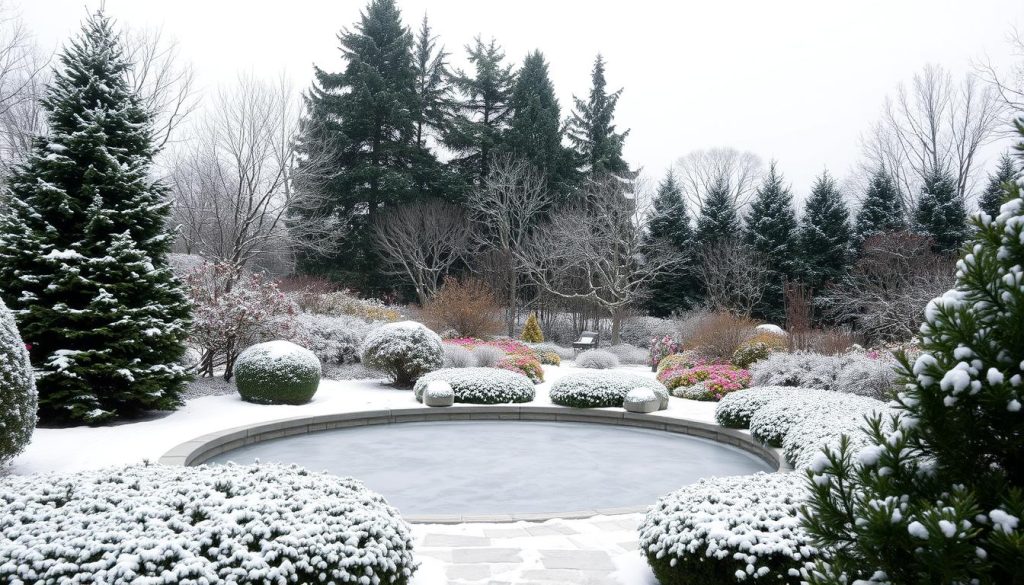
To make a winter garden design that grabs attention, you need to think about a few important things. The aim is to make a landscape that looks alive and organized, even when most plants are sleeping.
Layering Plants for Visual Interest
Good winter gardening ideas involve using plant layering to add depth and dimension. Here are some tips:
- Plant tall evergreen shrubs as background structures
- Use mid-height ornamental grasses for texture
- Add ground cover plants with interesting winter colors
- Select plants with varied bark textures and colors
Incorporating Pathways and Structures
Winter garden design isn’t just about plants. Architectural elements are key to keeping your garden looking good in the cold.
- Install stone or gravel pathways for winter walkability
- Add trellises for vertical interest and potential climbing plants
- Use decorative garden structures like arbors or pergolas
- Include garden sculptures or architectural elements
By using these winter gardening ideas, you’ll make a landscape that’s both engaging and beautiful all winter long.
Winter Gardening Tools and Equipment
Successful cold weather gardening needs the right tools and protective gear. Preparing your garden for winter means investing in quality equipment. This equipment must withstand harsh conditions and keep you comfortable while working outdoors.
Winter gardening tips start with understanding the essential tools. These tools make cold weather gardening effective and enjoyable. Specialized equipment helps protect your plants and makes gardening more comfortable.
Essential Tools for Winter Gardening
- Frost cloth for plant protection
- Cold frames to extend growing season
- Insulated pruning shears
- Soil moisture meter
- Sturdy garden spade with ergonomic handle
Protective Gear for Cold Weather Gardeners
- Waterproof and insulated gardening gloves
- Thermal layered clothing
- Waterproof boots with good traction
- Warm hat and neck gaiter
- Hand and foot warmers for extended outdoor work
Investing in quality winter gardening tools makes a big difference. Proper equipment protects both you and your plants during the coldest months. It ensures your garden thrives even in challenging weather conditions.
When selecting tools, look for durability and functionality. Choose items designed for cold weather gardening. They should withstand low temperatures and protect your plants and yourself.
Indoor Winter Gardening Options
Winter doesn’t mean the end of gardening. Indoor gardening in winter offers exciting chances for plant lovers. It lets you grow fresh produce and beautiful greenery indoors. Turning your indoor space into a garden can be rewarding and calming.
Winter gardening ideas can thrive at home with the right setup. The key is to create the best growing conditions for your plants.
Creating a Winter Indoor Garden
Setting up an indoor garden needs careful planning. Here are the essential elements:
- Choose a bright location with consistent temperature
- Invest in quality grow lights for enough light
- Select containers with proper drainage
- Use high-quality potting soil specific to indoor plants
Hydroponics and Vertical Gardening
Space-efficient growing methods can change indoor gardening in winter. Hydroponics is great for growing without soil, perfect for city living and small spaces.
- Install a compact hydroponic system
- Select plants suited to indoor environments
- Monitor nutrient levels and water quality
- Experiment with vertical gardening techniques
By using these winter gardening ideas, you can keep a thriving garden all winter. Start small, learn from each experience, and watch your indoor garden grow.
Frost Protection Techniques
Winter plant protection is key to keeping your garden healthy when it’s cold. Gardeners face big challenges when it gets chilly. But, with the right tips, you can protect your plants from frost.
To keep your garden safe from harsh winter weather, you need a plan. Cold temperatures can harm delicate plants. So, protecting your garden is vital for gardening success.
Using Row Covers and Cloches
Row covers and cloches are must-haves for winter gardening. They keep plants safe from freezing and strong winds.
- Row covers are lightweight fabric barriers that trap heat around plants
- Cloches provide individual plant protection, acting like mini greenhouses
- Use clear plastic or glass covers to maximize sunlight penetration
Strategies for Protecting Potted Plants
Potted plants are very vulnerable in winter. Using the right protection can save them.
- Move potted plants to sheltered areas near building walls
- Group containers together to create mutual insulation
- Wrap pots with bubble wrap or burlap for additional protection
- Consider bringing sensitive plants indoors during extreme cold
Successful winter gardening tips mean always being ready to protect. Know what your plants need and use these techniques. This way, you can keep your garden lively even in the coldest months.
Watering Practices During Winter
Winter gardening needs a careful touch when it comes to watering. As temperatures fall, plants need less water. It’s important for gardeners to know how to water during the cold months to keep their plants alive and growing.
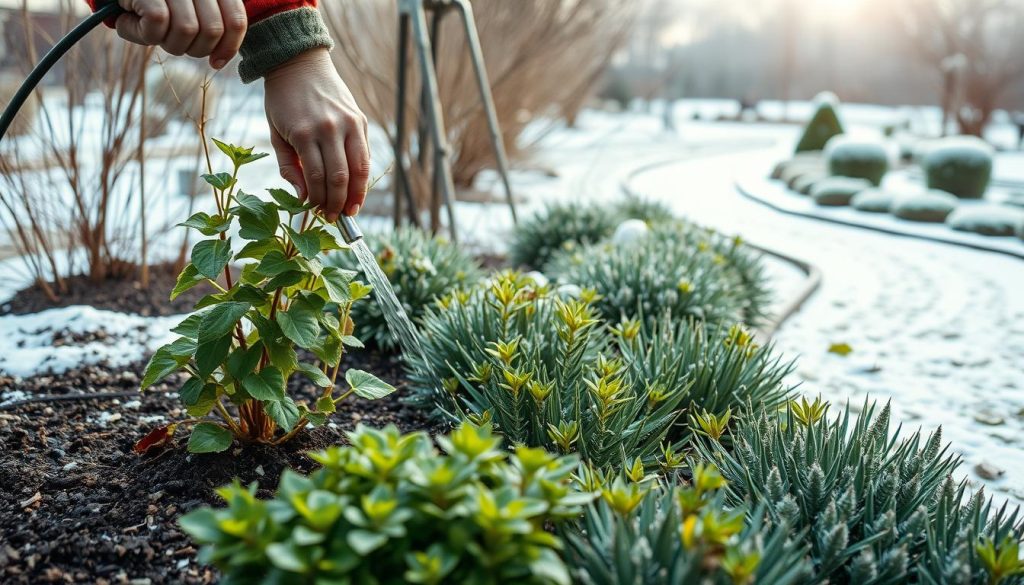
Winter gardening tips tell us to change our watering ways with the seasons. Different plants need different amounts of water in the cold. So, gardeners must find a special way to care for their winter gardens.
Understanding Plant Water Needs in Cold
Plants usually need less water in winter because they grow less and lose water slower. Important things to remember for winter watering are:
- Check soil moisture before watering
- Water during warmer parts of the day
- Reduce watering frequency for dormant plants
- Avoid waterlogging, which can cause root rot
Managing Indoor vs. Outdoor Watering
Indoor and outdoor plants have different needs in winter. Indoor plants might need more water because of dry air from heaters. Outdoor plants, on the other hand, need very little water. Here are some tips:
- Use room temperature water for indoor plants
- Protect outdoor plants from frost-related water damage
- Monitor humidity levels for indoor plants
- Adjust watering based on plant type and location
To keep a garden healthy in winter, know what each plant needs. Paying attention to the environment and each plant’s needs helps gardeners keep their gardens green even in the coldest months.
Pests and Diseases in Winter Gardening
Winter garden care needs careful attention to pests and diseases. It’s important to know the threats to cold-season crops and plants.
Winter gardens face pests despite the cold. Insects and diseases can harm plants all winter long.
Identifying Common Winter Garden Pests
- Aphids: Tiny insects that cluster on plant stems and leaves
- Slugs: Moisture-loving pests that can damage vegetable crops
- Spider mites: Microscopic insects that thrive in dry indoor conditions
- Overwintering insects: Eggs and larvae hidden in plant debris
Preventative Measures to Keep Plants Healthy
Keeping your winter garden healthy means being proactive. Use strategies to prevent pests and diseases.
- Clean garden tools and work areas regularly
- Remove dead plant material and garden debris
- Practice crop rotation to disrupt pest breeding cycles
- Use row covers and protective barriers
- Maintain proper plant spacing for air circulation
Natural pest control works well in winter gardens. Encourage beneficial insects and keep your garden clean to protect your plants.
Seasonal Maintenance for Winter Gardens
Winter garden care needs regular attention and planning. Gardeners must shield their spaces from harsh weather and get ready for spring. Successful winter gardening tips include watching over your garden and taking action early.
Keeping your garden safe in winter involves important steps. These steps help keep plants healthy and structures sound. Regular checks can stop damage and make your garden bloom in spring.
Essential Plant and Structure Checks
- Inspect garden structures for snow and ice damage
- Check plant roots for frost heaving
- Remove accumulated snow from delicate branches
- Assess protective coverings for wear and tear
Winter Pruning Guidelines
Winter pruning helps plants grow strong and keeps diseases away. Not every plant needs pruning in winter. Knowing what plants need is key for winter garden care.
- Prune dormant deciduous trees and shrubs
- Remove dead or damaged branches
- Avoid pruning spring-flowering plants
- Use clean, sharp pruning tools
Winter gardening tips focus on protection and gentle care. By following these steps, gardeners can keep their spaces safe and ready for spring.
Harvesting in Winter
Winter vegetable gardening lets gardeners enjoy fresh food even when it’s cold. With the right ideas, your garden can be a winter wonderland of fresh produce.
Knowing when to pick your winter crops is key. It keeps plants healthy and boosts your harvest. Some veggies taste better after a frost, making winter harvests extra special.
Timelines for Seasonal Produce
Winter veggies have their own picking times. Here are some important ones:
- Kale: Harvest from late fall through early spring
- Brussels sprouts: Best picked after first frost for enhanced sweetness
- Carrots: Can remain in ground and harvested as needed
- Spinach: Continuous harvest throughout winter months
Enjoying Winter Harvests in Your Kitchen
Winter gardening gives you fresh ingredients for cozy meals. Try these cooking and preserving tips:
- Roast root vegetables for warming dishes
- Create winter soups and stews
- Pickle excess produce for later use
- Freeze vegetables for long-term storage
With good planning and care, your winter garden will give you nutritious, tasty food all season.
Resources for Winter Gardeners
Winter gardening needs ongoing learning and support. Gardeners can find great resources in books, online, and local groups. The University of Minnesota Extension and Rodale’s Organic Gardening share top tips for winter gardening.
Digital communities have changed how we share winter gardening tips. Sites like GardenWeb and Reddit’s r/gardening offer forums for advice and problem-solving. They help both new and seasoned gardeners find practical help.
Books and Online Communities
Books like “The Winter Harvest Handbook” by Eliot Coleman and “Year-Round Vegetable Gardener” by Niki Jabbour are full of useful info. Online, Pinterest and YouTube have many gardening channels with tutorials and guidance.
Local Gardening Groups and Support Systems
Local gardening clubs and extension offices are key for winter gardening success. They offer workshops, seed exchanges, and local advice. Joining these groups can really boost your winter gardening skills.
